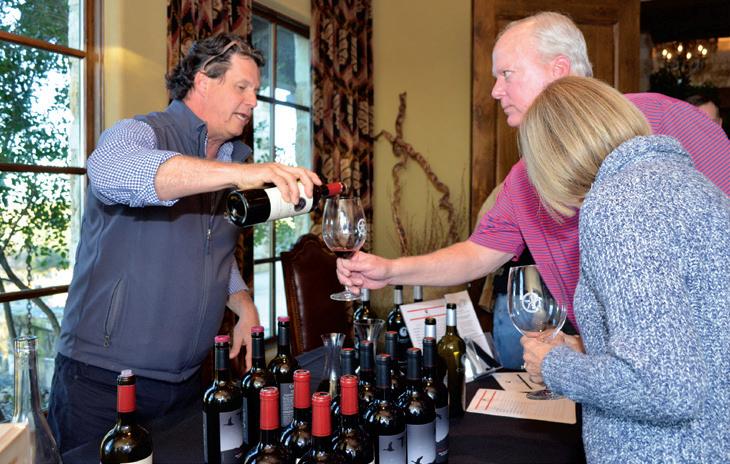
10 minute read
2021 WINE EXTRAVAGANZA AND FOOD FESTIVAL
NOVEMBER 23 :: 6:00 TO 8:30PM
By Jeffrey Cohen, Wine Specialist
Advertisement
I would like to personally invite you all to the Wine Extravaganza and Food Festival this year. This year’s holiday show will take place in the Clubhouse. As in years prior, the format will be Bubbles and Big Reds. This is a perfect opportunity to buy holiday gifts and stock your cellars.
We will have 13 wine vendor tables with over 50 selections to “Try before you Buy.” We will also include food stations that will cover selections from eight different countries: Germany, France, Italy, Spain, Argentina, New Zealand, Israel and the good old U.S.A.
We will be limiting the event to 80 people so please plan accordingly and make your reservations early.
This will be the absolute best Bubbles and Big Reds to date!
I hope to see you there!
Jeffrey Cohen is the Wine Specialist at The Clubs of Cordillera Ranch. He can be reached at jcohen@cordilleraranch.com.
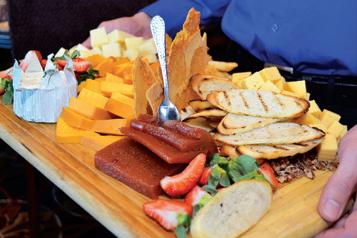

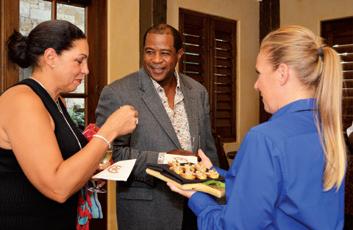


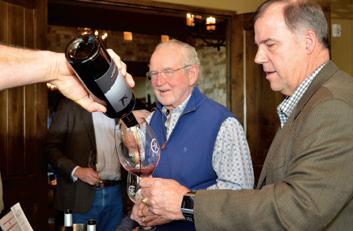



The UNITED STATE of PILATES
By Kris Cracknell :: Photography by Jason Risner


This week I got a ping on my phone from a friend doing battle with some ongoing low back pain. After consulting with a physician and completing physical therapy, my friend was advised to incorporate more “glute and core” exercises into workouts. Being a resourceful person, my friend googled “glute exercises” then forwarded a link to me with these words: “need to work on isolating my glutes, what do you think about these exercises?” My brain immediately and automatically shifted into teacher mode. I had only one thought: Isolate? Please don’t let your glutes work out alone!
As a Pilates instructor and a human who has surpassed the half way point in her life, I know that isolating one muscle to create strength comes at a cost. Without help from another muscle group, things can and will go very wrong. I also know that my friend’s mission to strengthen the glutes was well intended. It was the idea of solely focusing on one very specific area without regard to another that raised my concern.
Many years ago, when I first started my own Pilates practice, I was struck by how different my body felt moving in a Pilates class versus how it felt in my usual group classes. The biggest difference in my Pilates class was that every single exercise called upon my body to shift what part of me was moving and what part stayed stable — with a very strong emphasis on the stability part. I had no idea how incorporating both mobility and stability in every single move would change how I work out, how I ski, how I hike mountains with my family and how I move through life. In fact, it is safe to say that before I was introduced to Pilates, I had very little awareness of mobility and stability and how that pertains to my body as an entire movement system.
The Merriam-Webster dictionary defines “united” as 1. made one; combined, 2. relating to or produced by joint action, 3. being in agreement; harmonious. Thank you, dictionary people. I cannot think of a better adjective to describe the perfect Pilates workout. It is the body working in a united state — using both mobility and stability in each exercise, providing an effective and efficient workout.
Pilates is a whole-body exercise program. We don’t just emphasize one body part. We address the entire system and how it works together for optimal benefits and better movement! What does that mean? In the context of movement, let’s break it down with a general definition of mobility and stability. Skeletal muscle tissues can hold things together or move parts relative to each other; both parts are equally important. Mobility refers to the ability of a joint to move freely through a certain range of motion without restriction from the surrounding tissues. The stability aspect refers to the ability to recruit the muscles around the joint in order to prevent movement. It is the constant shift between the two that helps us to gain strength and prevent injury. Both are equally important!
Many of the most common injuries and complaints that I see and hear begin with problems in assigning the right muscle to the right job. An example of how the synergistic body parts work together is walking. Ideally, the large glute muscles are used along with their connectors from the pelvis to the hip to push the leg forward (mobilizing) as it lifts off the ground while keeping your spine upright (stabilizing.) Pro tip: if you’re shuffling your feet when you are walking, please wake up your glutes and tell them to get to work.
Still unsure if your muscles are doing their job correctly? Let’s meet! In a one-hour Pilates session, you will move through a series of exercises created to highlight both mobility AND stability. We know that systems work best in unison; our bodies are no exception. The human body is designed to move, and efficient movement involves numerous muscles and joints working together simultaneously. Limitations in either of these areas leads to compensation somewhere in the system creating faulty movement patterns and increased risk of injury. This is a very common occurrence and happens to most people at some point in their life (myself included!). If you’ve already experienced an injury, don’t worry. Once you’ve been given clearance to exercise, Pilates will meet you where you are. With the right guidance, consistency and commitment, new and healthier movement patterns can be created. Pilates is here for that and I am, too. I can’t promise you six pack abs or that doing “these four glute exercises will erase your back pain!” And in the continued interest of full disclosure, I am known to lose track of counting repetitions. But I can promise that I will be tracking your form and movement. That is my priority. I can also promise that in Pilates, we will work together in a united effort to improve the way you move. By moving and working together, we are stronger!
Kris Cracknell is the Pilates Instructor at The Clubs of Cordillera Ranch. She can be reached at pilates@cordilleraranch.com or 210.860.7322.
The Advantages of The Advantages of Float Fishing Trips Float Fishing Trips

By Shane Reynolds, Outdoor Recreation Director & Outfitter
Fishing float trips, either fly or conventional, offer many advantages to both novice and expert anglers. While wade fishing a river or stream is a pleasant way to spend a few hours stalking trout or bass, a float trip down a river gives fishermen opportunities that can’t be matched from shore. For the last thirty years as a guide, I have spent countless hours fishing with clients and I believe float fishing is often the best way to maximize the potential of catching more fish. It’s also a peaceful and easy way to fish.
COVERING WATER
The biggest advantage of a float trip is simply the fact that drifting down remote water allows anglers to put their flies and tackle over more trout and bass than is ever possible while wading. Rather than casting to the same fish over and over, from a raft, every new riffle, undercut bank and bend in the river creates new possibilities with trout that are often unreachable by anglers who are limited by walking or by rivers that are too deep to cross safely. Anglers who do enjoy wading are able to get out of the boat to thoroughly fish prime areas that rarely see other wade fishermen. Dry fly fishing and streamer fishing generally require wading anglers to stay on the move to look for new fish, but from a boat, each cast puts your dry fly or streamer into new territory.
FISHING PRODUCTIVE BANK WATER
Wading anglers are often standing where the fish would prefer to be feeding. Banks offer both security and food for trout and bass. Grasshoppers, ants, frogs and insects commonly fall into the water near the bank and the fish look for them there, sometimes holding mere inches from shore. From a boat, these productive holding areas can be fished easily without spooking the fish.
MOBILITY ISSUES
Some fishermen just have trouble wading safely. Older anglers and young children can be challenged when dealing with moving water and slick rocks. Even experienced anglers can have trouble wading in high, fast currents. Float fishing trips eliminate the risk of trying to negotiate rushing water, over “greased bowling balls,” logjams and other wading hazards. Anglers can comfortably fish while standing or sitting in a raft and relax to take breaks to enjoy the scenery if they get tired. Often, it isn’t even necessary to wear waders, which makes for a more comfortable day when the mercury rises on summer afternoons.
TECHNICAL ADVANTAGES
Fishing from a raft also allows the guide to give his anglers a better shot at catching more and bigger fish. From an elevated position above the water, fly casting is made easier. In addition to casting, mending, setting the hook and spotting fish are all easier from the higher location anglers fish from in a raft. Longer “drag free” drifts can be achieved while the boat drifts with the flies. In the event a truly large, trophy-sized fish is hooked, playing the fish is easier from the boat. The guide is also able to follow the fish should it decide to go on a long run downstream. Rising trout can be approached from upstream. The first thing they see is the fly drifting towards them. This increases the percentage of hookups and decreases the chance of spooking fish.
CARRYING GEAR AND PEOPLE
All wade fishermen must carry what they may need on their backs. In a boat, lunch and drinks are kept cold in a cooler. Cameras can be stowed in dry storage, and extra rods can be brought along in the boat. Additionally, two anglers can fish from the same boat. It’s nice to have a buddy to converse with throughout the day. It’s also great to have someone to snap photos of your trophy fish.
WHAT TO BRING
Generally, our outfitter staff will have you covered for flies, gear and water, but bring your own equipment if you prefer. As mentioned earlier, waders are often optional. A buff face and neck guard is an excellent way to avoid a sunburn. The technical fabric breathes and beats the sun coming from above and reflecting off the water. A lanyard for tippet, clippers, hemostats and floatant is handy. Don’t forget raingear, polarized sunglasses and sunscreen.
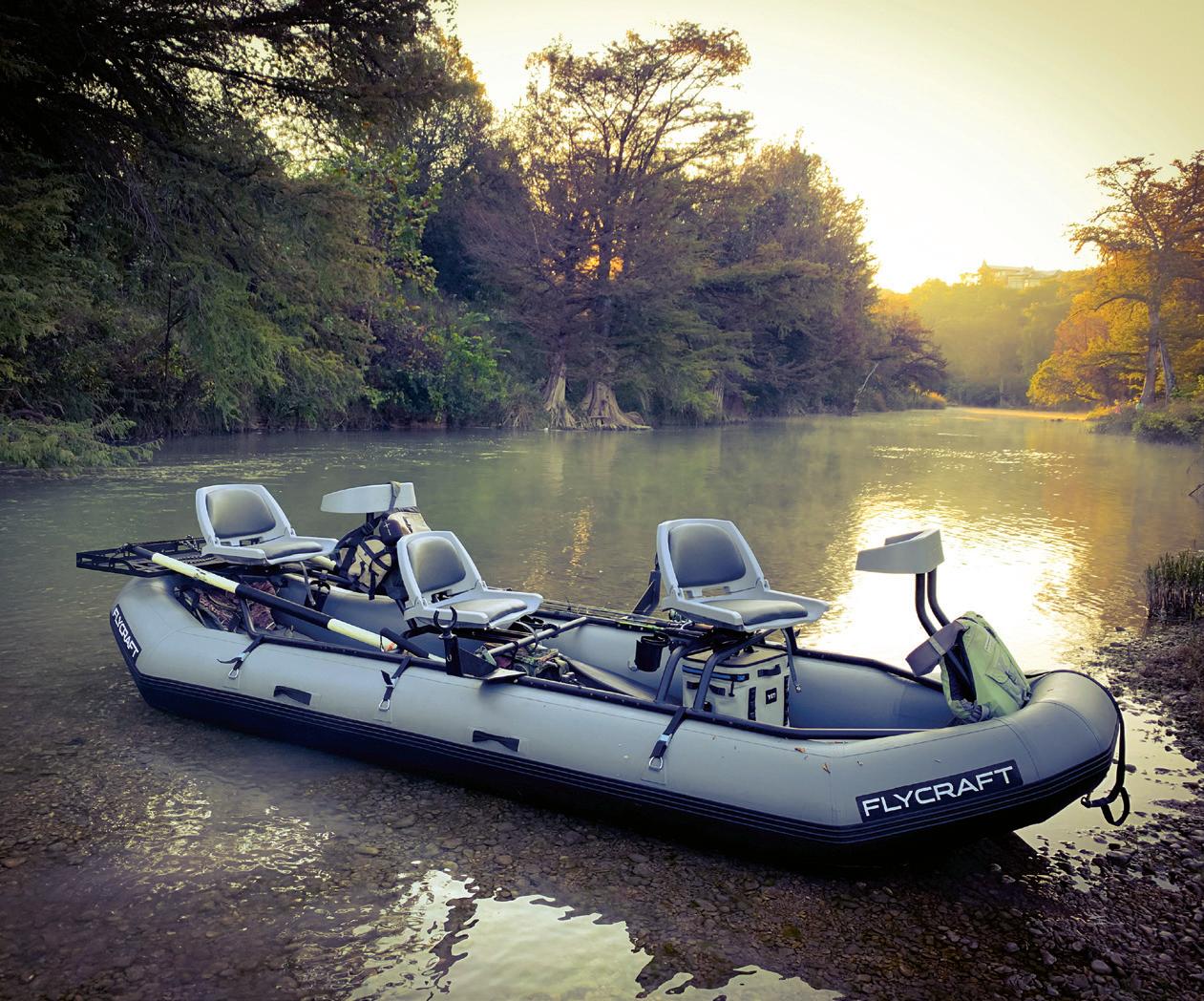
Wading is a great way to get close to the fish and immerse yourself in the environment bass and trout call home. However, it is hard to beat a day of floating down a beautiful river like the Guadalupe, San Marcos, Llano or Devils. All while your outfitter staff rows and offers instruction. The scenery and wildlife alone are worth a float. However, you will cover more water and cast to more trout and bass than is possible on any wade fishing trip.
FISHING TRIPS
The outfitter service at The Clubs of Cordillera Ranch focuses on a few bodies of water for our fresh water float trips. The trout season on the lower Guadalupe River in Satler runs from November through April. On that particular trip, we are fishing the tailrace below Canyon Lake for stocked Rainbow and Brown trout, stocked by Trout Unlimited and the State of Texas.
On the upper Guadalupe in and around Cordillera Ranch, we are targeting warm water species such as the Guadalupe bass, various species of sunfish and even carp.
On the San Marcos and Llano Rivers, we also target warm water species such as largemouth bass, Guadalupe bass, various sunfish and cichlid, as well as carp.
On our favorite river, the Devils, which flows into Lake Amistad north of Del Rio, we are targeting smallmouth bass, largemouth bass, gar and carp. The Devils is the most pristine river in Texas by far.
For more information on guided float fishing trips, contact the Outfitter Center at The Clubs of Cordillera Ranch.
Shane Reynolds is the Outdoor Recreation Director and Outfitter at The Clubs of Cordillera Ranch. He can be reached at outfitter@cordilleraranch.com and 210.616.6051.










